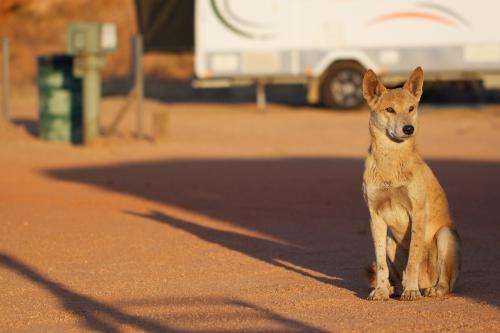The findings reveal that dingo populations are present and increasing in all Australian sheep production zones. Credit: sunphlo
New research suggests that unless drastic action is taken to control dingo incursions, rangeland production of wool and sheep meat in Western Australia will disappear within 30 to 40 years.
Published in the Australian Veterinary Journal, the findings reveal that dingo populations are present and increasing in all Australian sheep production zones, including south-west of WA and areas once declared 'dingo free'.
"The pattern of sheep decline, evident for over 100 years outside exclusion zones, is presently occurring in exclusion zones, with all states experiencing flock size reductions of 40 per cent or more," co author Dr Benjamin Allen says.
"This is primarily due to the diminished use of fences and fences having fallen into disrepair, which has resulted in dingoes reinvading areas where control has occurred or where they had previously been exterminated."
Dr Allen drew on landholder surveys undertaken by the WA State Government as well as a recent dingo genetics study by Dr Danielle Stephens, done through UWA, which used microsatellite DNA markers to produce the first study of population genetics in Australian wild dogs, including dingoes (Canis lupus dingo), feral domestic dogs (C. l. familiaris) and their hybrids.
Dr Stephens' study found samples from outside and inside barrier fences in WA.
Mr Ross Wood of the Kalgoorlie Pastoral Alliance (KPA) says the Goldfields are a prime example of dingoes' ongoing impact.
"People think you can get away with one or two dogs in a protected area, but you can't run sheep with any predators. If ewes detect predators in the area, they'll walk away from their young," he says.
"High lambing rates are needed to make production economically feasible, so any incursion is a disaster. The Kalgoorlie Pastoral region supported 300,000 sheep up until the 1990s. Now we have less than 2000, and that's mainly due to dingoes.
"If that situation is occurring in other parts of the country, the outcome is clear."
Mr Wood says current control measures such as trapping, baiting and bounties are not effective, because trying to control dogs without preventing reinvasion will never succeed.
As an alternative, KPA has done a full cost-benefit analysis to support the building of a 950km-long biosecurity fence to facilitate long-term removal of the wild dogs, goats and other feral animals from the Kalgoorlie Pastoral region.
"There are clear economic, social and environmental benefits to supporting the sheep industry in WA, so we hope people get on board," Mr Woods says.
More information: Allen, B. and West, P. (2013), "Influence of dingoes on sheep distribution in Australia." Australian Veterinary Journal, 91: 261–267. doi: 10.1111/avj.12075
Provided by Science Network WA























